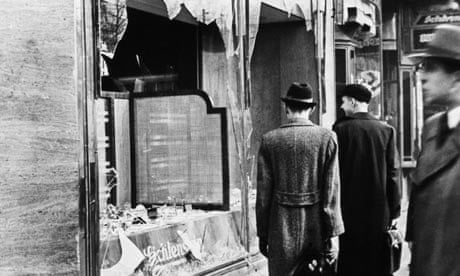A huge dumping ground for the destroyed remains of Jewish property plundered during Kristallnacht has been found north of Berlin by an investigative journalist.
The site, which is the size of four football pitches, in Brandenburg, contains an extensive array of personal and ceremonial items looted during orchestrated nationwide riots against Jewish property and places of worship on the night of November 9 1938. It is believed the goods were brought by rail to the outskirts of the village and dumped on designated land.
Yaron Svoray, the Israeli journalist who made the discovery, said it was a happy coincidence that he had stumbled across the artefacts so close to the 70th anniversary of the pogrom, also known as the Night of Broken Glass.
"I wasn't fully aware of the historical significance of the find until it was pointed out to me by a historian," Svoray told the Guardian. "We were looking for something completely different when we came across all these items and trinkets."
Svoray, a private detective turned journalist who has a list of wartime-related investigations to his name, was researching a story on the nearby hunting lodge of the Nazi Luftwaffe commander, Hermann Göring, when the local forester, who had been a young boy at the time of the Kristallnacht, pointed out the rubbish dump. Under mounds of earth Svoray uncovered the first items within two hours. "The locals of this site have basically been living with this dark hidden secret for 70 years," he said.
Among the items he found were glass bottles engraved with the Star of David, Mezuzahs, painted window sills, and the armrests of chairs found in synagogues. He also found an ornamental swastika. His search continues, under the protection of bodyguards after threats to his life.
Svoray has been wary of making his find public because the site might attract far-right treasure hunters. "There's no treasure as such here, but there's still the danger of it turning into some skinhead circus eBay special," he said, urging the government to secure the site.
The British historian Martin Gilbert, author of Kristallnacht: Prelude to Destruction, which illustrates how the event paved the way for the Holocaust, marking the moment when race hate became sanctioned by the German state, said the size of the rubbish dump was not a surprise considering the scale of the destruction that took place- about 1,400 synagogues, other Jewish religious establishments as well as people's homes were completely, or partially, destroyed.
"Most of the interiors of the synagogues - seats, cupboards, pulpits etc - were taken away as loot. Most of the interiors of ransacked Jewish shops were likewise taken away as booty by neighbours and looters. Other interiors were set on fire. It will be interesting to see precisely what the items are."
Tanja Ronen-Löhnberg, an educational historian at Ghetto Fighters' House, a Holocaust research centre in Galilee, Israel, said the items' authenticity had been verified. "We don't want to falsify history, so we sent historians who confirmed these items belonged to the time."
The centre plans to organise a project for German and Israeli children to search together through the remains.
Yaron Svoray
The son of Holocaust survivors, Yaron Svoray is a detective, Nazi hunter, FBI operative and journalist best known for his undercover six-month investigation of German neo-Nazis in the 1990s. In Hitler's Shadow, the book based on that investigation, was turned into a 1995 film. In 2005, he found the hidden possessions of Jewish prisoners of a concentration camp in Poland; his hunt for Nazi-era diamonds earned him recognition and led to the film Blood from a Stone (History Channel), as did his dive in Lake Toplitz, Austria, to recover forged Nazi money. He has also carried out an investigation into snuff films
Prior to stumbling across the Kristallnacht rubbish tip, he was working on a film about Göring's hunting lodge, Karinhall, near Berlin, as well as a film on the Odessa organisation, which helped Nazi war criminals escape to South America at the end of the second world war.
